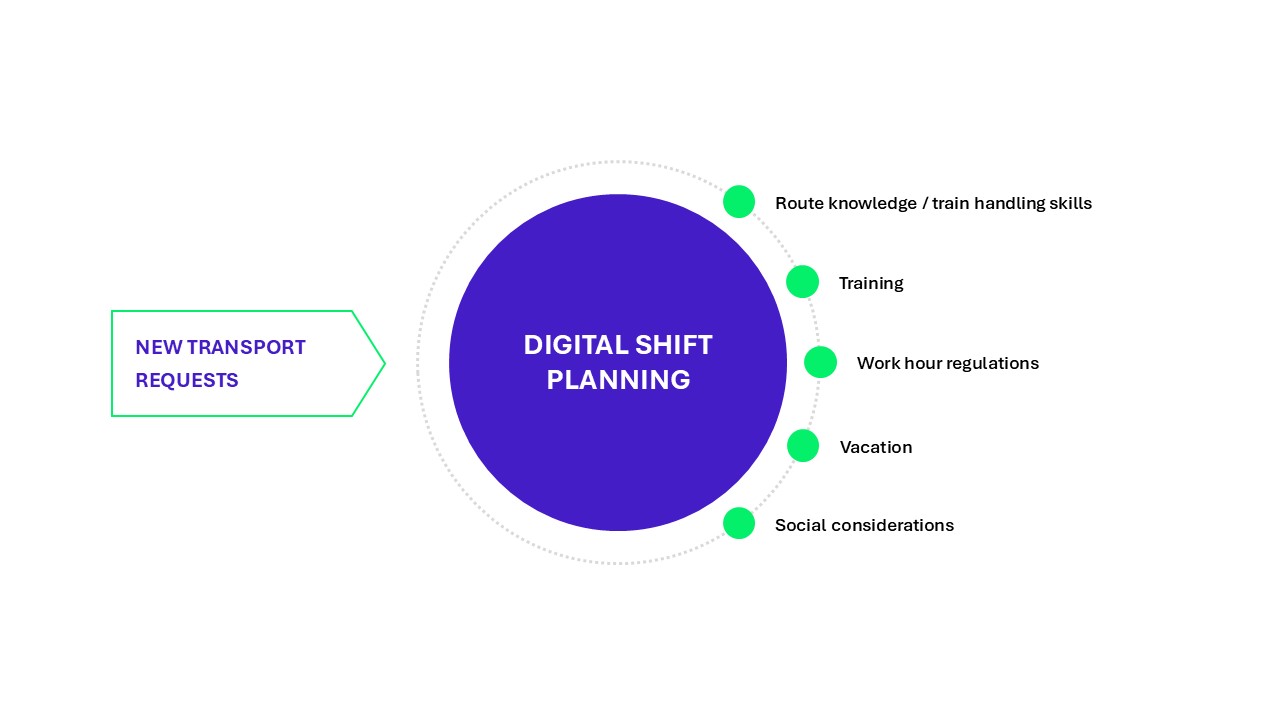Planning and scheduling: How algorithms help railway companies become more efficient
Published May 8, 2024
- Sourcing & Services Optimization
- Travel, Transport & Logistics

With critical skills shortages and massive time constraints, highly efficient planning and scheduling is critical for railroads to ensure sustainable profitability in the future. With the right software and intelligent algorithms, they can automatically evaluate scenarios to optimally deploy staff and trains.
The result is impressive productivity gains.
The providers of software for the optimized use of resources by railway companies have documented the effect:
Depending on the situation, railway companies can reduce staff requirements by 5-10%. Even at 5% a mid-market railway company with 100 drivers could save €250,000 annually.
(assuming an average annual salary of €50,000, including non-wage labor costs)
How railway companies can best deploy their trains and train drivers
In the future, railroad companies will have to increasingly avoid empty runs, and given the dramatic shortage of skilled workers, make increasingly efficient use of their valuable train drivers.
The key to this is thorough digital planning, and scheduling that leverages analytics and algorithms.
Tools automate the planning processes and calculate a multitude of possible variants to find the most efficient one – always pulling from complete and up-to-date master data that every railway company will want to accurately capture in the future.
Sensors installed in the trains and the train drivers themselves will feed the system with up-to-date data for timely scheduling. This way, railway companies can make the most of operational flexibility and low production costs.
In just a few years from now, this scenario will be the standard.
Variable scheduling simulation for efficient personnel planning
An annual timetable starts out as a static model.
But things get dynamic once it is put into operation. Weeks or just days before the scheduled departure, transports are cancelled or added, employees call in sick or go on strike.
With tight capacities, railway companies must keep rescheduling to accommodate last minute changes.
Shift planning for train drivers in rail freight transport is a perfect example for the efficiency gains achieved through optimization algorithms that help railway companies unlock their economic potential.

The more efficient a transport company gets in using its operational resources, the more sustainable it becomes in its day-to-day operations.
The static annual timetable with realistic locomotive rotations has been prepared. Now it is time to plan shifts which accommodate the many different requirements, including work hour regulations.
Personnel deployment is to be as cost effective as possible, but still companies want to retain the flexibility to respond to short-term changes. They need to be able to determine quickly what route experience is needed and to what extent, which personnel is available at which deployment location, i.e. who is not currently on vacation, sick, or undergoing training etc.
Throughout all this, shift planning must ensure efficient use of time and resources, meaning that train drivers should spend as much time as possible driving their trains.
There are many details to consider such as commuting distances, servicing of trains, and much more. Given the multitude of factors at play, only a software-based solution will be able to stay on top of the many possible variants concerning the deployment of personnel, to find the best one. This is one of the reasons why software will become the standard in scheduling.
Deploying a planning software will also increase cost-efficiency by reducing the hours that train drivers travel as guests. On top of that, optimized planning will also positively impact employee satisfaction.
After all, a software solution never loses track; train drivers will not be operating the same routes repeatedly, allowing them to maintain their knowledge of various routes and destinations.
This is how digital shift planning works
The software will suggest shifts and work schedules, considering dependencies on route knowledge and train handling skills along with vacation schedules, training, and work hour regulations.
It will flexibly integrate any new transport requests and simulate shifts that ensure utmost efficiency. This will contribute to keeping personnel needs as low as possible and help incorporate social considerations like shift preferences.

How algorithms make planning and scheduling smart
Algorithms can try out variants in the bidding phase and simulate resource requirements in different situations, contributing to realistic costing.
Railway companies also get a clearer picture of whether to add new dispatch locations, to have operating crews spend the night at a hotel, or to bring in external help because it is more cost effective.
The foundation: Railway companies need clean and accurate master data
The solutions for resource planning and scheduling use what is known as optimization algorithms that are capable of presenting variants in a concise manner. These algorithms use data that is already available in the solutions. Sound and reliable planning and scheduling, however, needs accurate and complete data pulled from a single source of truth.
This in turn means that some railway companies may have to launch data projects alongside their software implementation projects because the availability of clean master data is non-negotiable. To maintain this data, railway companies will have to create dedicated roles that perform a cross-departmental function with the objective of defining and implementing the necessary data structures.
The various entities will have to collect data in a consistent manner so that it can be used in resource planning and scheduling.
The importance of accurate and integrated master data is illustrated by looking at the example of train drivers. Information on their various skills, such as route knowledge and train handling skills, must always be kept up to date – be it by the train drivers themselves using a mobile app, by administrative staff, or other staff throughout the organization. This in turn means that the master data must correlate with the route data in the system so that the software can match train characteristics to suitable personnel.
In a nutshell: software-based planning and scheduling requires professional master data management. Railway companies that want to create processes that stand the test of time should consider bringing in external expertise.
Planning the deployment of locomotives and trains digitally
Trains are rotated based on computer calculations that consider dependencies on route, vehicle type (load, electricity/diesel), turning times, servicing (time/kilometre), cleaning, and refueling. This helps railway companies ensure efficient rotations with optimized vehicle requirements, while keeping their vehicle holding costs and operating costs at a minimum.
Conclusion: Railway companies will go digital in their planning
Going forward, railway companies will need intelligent algorithms to become more efficient in their deployment of resources and reduce overall costs along the way; two factors inherently crucial to their success.
Digital transformation of planning and scheduling is the way to go.
Especially when it comes to having to make short-term resource planning and scheduling decisions, software that calculates the best variants under intense time pressure and with few planners is indispensable.
These solutions reveal their true potential in situations where trains must be urgently deployed. Software enables planners and dispatchers to make quick decisions as to which locomotive is best transferred from where to compensate for the unexpected unavailability of an engine or as to which train driver to bring in to substitute for a sick colleague.
We will be happy to help you make your vision of flexible and forward-looking resource planning and optimization a reality and find a digital solution that is right for you.
Author
-

Dr. Isabella Geis
Associate Partner – Germany, Frankfurt am Main
Wavestone
LinkedIn